| Home | Nature Weekly Index |
27 April 2014 | Grasshopper | Sungei Buloh Wetland Reserve |
I just missed the bus to Mandai area when I arrived at the bus stop last Saturday. Then, I saw the bus going to Sungei Buloh Wetland Reserve (SBWR). In the spur of the moment, I decided to board that bus and head to SBWR instead of waiting another 15-20 minutes. My last visit to SBWR was a long time back in July last year. The NPark upgrading project in that area was still ongoing --- seems to be going on for a long time too.
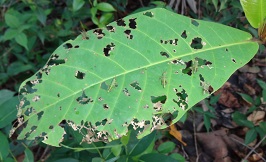
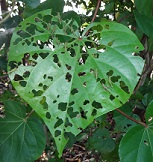 These days, SBWR is not top on my place-to-visit list as the chance of finding any new plant for my website is very low.
I get to find more interesting creatures such as ants, beetles, bugs and grasshoppers than discovering plants new to me.
The place has plenty of grasshoppers and they are quite easy to spot. This time round, there was a flourishing population
of grasshopper nymphs seen defoliating the leaves of mainly two common plants, namely
Sea Hibiscus (Talipariti tiliaceum) and
Sea Almond (Terminalia catappa), found in mangrove area.
These days, SBWR is not top on my place-to-visit list as the chance of finding any new plant for my website is very low.
I get to find more interesting creatures such as ants, beetles, bugs and grasshoppers than discovering plants new to me.
The place has plenty of grasshoppers and they are quite easy to spot. This time round, there was a flourishing population
of grasshopper nymphs seen defoliating the leaves of mainly two common plants, namely
Sea Hibiscus (Talipariti tiliaceum) and
Sea Almond (Terminalia catappa), found in mangrove area.
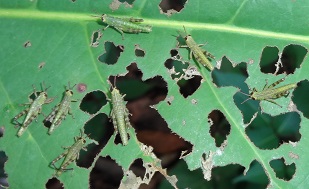
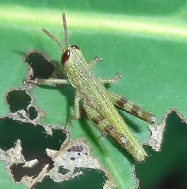 As the nymphs were small and their green in colour, I had to get closer to the tattered leaves before I discovered them
still feeding on the leaves. The nymph population was available in several locations in the Reserve, though more condense
in some areas. As they all looked very similar, I suspected that they were from the same species of grasshopper.
As the nymphs were small and their green in colour, I had to get closer to the tattered leaves before I discovered them
still feeding on the leaves. The nymph population was available in several locations in the Reserve, though more condense
in some areas. As they all looked very similar, I suspected that they were from the same species of grasshopper.
.jpg)
These grasshopper nymphs were quite common as I had seen them in many places over Singapore but had failed to identify the adult grasshopper. There was one common grasshopper in parks, including SBWR, known by its scientific name Xenocatantops humilis. Unlike other insects such as dragonflies and butterflies, grasshoppers generally were not assigned with common names. There were publications on grasshoppers (scientifically classified under the family Acrididae) in Singapore but they were highly scientific, which were unpalatable for lay person likely myself. I was not sure whether a pictorial reference booklet was available but did not remember seeing one.
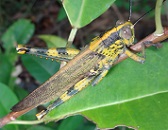
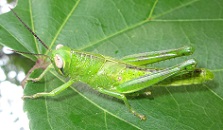
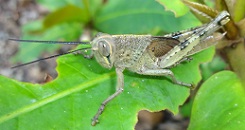 The other suspect is the
Javanese Grasshopper (Valanga nigricornis).
This is the largest grasshopper in Singapore. The adult is yellow in colour with dark patches over its body. It should be
rather common but not as easy to spot when compared to the smaller Xenocatantops humilis. I happened to find an
adult and 2 late-stage nymphs during this trip but was not certain on the look of its early-stage nymph.
The other suspect is the
Javanese Grasshopper (Valanga nigricornis).
This is the largest grasshopper in Singapore. The adult is yellow in colour with dark patches over its body. It should be
rather common but not as easy to spot when compared to the smaller Xenocatantops humilis. I happened to find an
adult and 2 late-stage nymphs during this trip but was not certain on the look of its early-stage nymph.
As the host plants are very common, the multiplication of the grasshoppers is not really a concern. They are just part of the food chain in the ecosystem that will eventually regulated by itself.